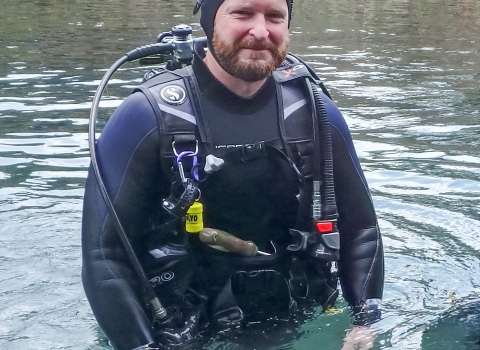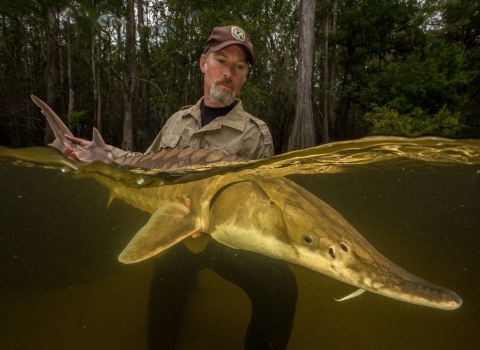Food, water and shelter are the basic needs for all life on Earth. We at the U.S. Fish and Wildlife Service know that clean water and native habitat are essential to wildlife, as well as to the health and well-being of the people who share that same landscape. Thanks to funding from the Inflation Reduction Act, we have been undertaking a once-in-a-generation conservation project with the aim of making life better across America’s heartland. Learn more about how we’re working with our counterparts from state, federal, Tribal and non-governmental organizations.
The Prairie Pothole Region Landscape Conservation and Restoration Project spans a huge geography – from Montana and the Dakotas, east to Minnesota and further south into Iowa. This decades-long project will devote more than $23 million to restoring and enhancing the resilience and ecological function of grasslands and wetlands throughout the 26 wetland management districts and conservation areas. Our goal over the next few years is to restore, reconstruct and enhance at least 15,000 acres of grasslands and 5,000 acres of wetland by the completion of this project.
Collectively, these large-scale restoration, reconstruction and enhancement projects serve as natural climate solutions to absorb and store atmospheric carbon within grassland and wetland ecosystems. In addition to the ecological benefits, the project will provide several important societal benefits by improving environmental health, decreasing the risk of natural disasters and increasing access to open space for everyone, regardless of their zip code.
How did we prioritize our work across such a huge landscape? We followed the science and used existing partnerships through the Prairie Pothole Joint Venture and the Central Grasslands Roadmap, as well as other population modeling tools that were developed by our U.S. Fish and Wildlife Service team.
Learn more about the specific geographies and organizations that we are collaborating with to bring about this massive project:
North Dakota, South Dakota and Montana
The U.S. Fish and Wildlife Service has joined hands with Ducks Unlimited, Pheasants Forever and the North Dakota Natural Resources Trust to restore and improve wetland and grassland habitats in the Prairie Pothole Region of North Dakota, South Dakota and Montana. This partnership will provide technical assistance and on-site implementation of identified projects that help improve and restore wetland and grassland habitats throughout the region. These projects aim to benefit breeding areas for grassland birds, waterfowl, pollinators and endangered species.
The initiative began in 2023, and 100 potential project sites on U.S. Fish and Wildlife Service, state and perpetually protected private properties have been identified. Our agency has granted $5 million to cooperative agreements with these partners. The first projects include grassland restoration, which are expected to be completed by Spring 2024. A high-diversity seeding on a newly acquired waterfowl production area waterfowl production area
Waterfowl production areas are small natural wetlands and grasslands within the National Wildlife Refuge System that provide breeding, resting and nesting habitat for millions of waterfowl, shorebirds, grassland birds and other wildlife. Virtually all waterfowl production areas are in the Prairie Pothole Region states of Iowa, Minnesota, Montana, North Dakota and South Dakota.
Learn more about waterfowl production area that was previously farmed and is adjacent to Arrowwood National Wildlife Refuge is an example of this work. This action aims to expand the grassland footprint and public uses, including bird watching, hunting and other recreational activities on existing managed lands. Overall, the goal is to restore or enhance 5,000 acres of grasslands and 1,700 acres of wetlands.
Western and central Minnesota
Our work in Minnesota will be focused throughout the western and central parts of the state, where we'll be collaborating with conservation professionals from Pheasants Forever, Ducks Unlimited, The Nature Conservancy and the Minnesota Land Trust to support partnerships that will assist with the restoration of more than 200 finite project units. Additionally, we’ll be coordinating with private landowners as we support their interest in restoring, or in some cases to enhancing, habitat through perpetually protected conservation easements while sustaining working lands.
The Minnesota Department of Natural Resources has requested funding for a proposed 13 projects that will restore or enhance wetlands and grasslands on state-owned wildlife management areas across 860 acres. State biologists and other natural resources professionals will simultaneously be using a combination of wetland and grassland restoration and enhancement techniques, including high diversity pollinator seedings on most units. Thinking strategically, the team selected specific locations given their proximity to existing federally managed waterfowl production areas that receive small wetland treatments and state-defined Minnesota Prairie Plan Focus Areas.
A concentrated focus area of projects is located in the southwest corner of Otter Tail County, within the Minnesota Prairie Plan Corridor and amidst already completed and planned wetland restoration projects on existing U.S. Fish and Wildlife Service waterfowl production areas. We will be directing $980,000 in Inflation Reduction Act funding for these projects with a commitment to leverage state climate funding as needed.
Iowa - Dickinson County and more than seven counties
The Iowa Department of Natural Resources has requested funding for a proposed 24 projects across more than 588 acres of restored or enhanced wetlands and grasslands on state-owned wildlife management areas. Our state counterparts will be implementing wetland enhancement techniques on 176 acres within four project units. They will also be using wetland restoration techniques on 133 acres within 13 project units. Additionally, our state counterparts will be using various grassland restoration techniques on 278 acres within seven project units.
A concentrated focus area of projects is located along the Minnesota and Iowa border in Dickinson County and would contribute to larger wetland complexes with vital habitat for waterfowl and other declining species. Inflation Reduction Act funding requested for these projects is $980,000 and the Iowa Department of Natural Resources has currently set aside $50,000 in matching funds.
In March of 2023, the U.S. Fish and Wildlife Service announced an investment of more than $120 million from the Inflation Reduction Act to rebuild and restore units of the National Wildlife Refuge System and partnering state wildlife management areas that have been affected by adverse weather events. The investment prioritizes projects that promote coastal resilience and climate adaptation, address invasive species invasive species
An invasive species is any plant or animal that has spread or been introduced into a new area where they are, or could, cause harm to the environment, economy, or human, animal, or plant health. Their unwelcome presence can destroy ecosystems and cost millions of dollars.
Learn more about invasive species threats, and provide for additional data collection needed to support successful natural resource resilience.
Through these investments, we are working with state partners to complete geographically diverse, large-scale projects that are mutually beneficial for these conservation areas, including projects that benefit underserved communities and Tribal interests. The program supports the Biden-Harris administration’s America the Beautiful Initiative, a decade-long challenge to pursue locally led and voluntary conservation to protect, conserve, connect, and restore our nation’s lands, waters, habitats and wildlife.
Learn more about how the U.S. Fish and Wildlife Service is implementing the Inflation Reduction Act




